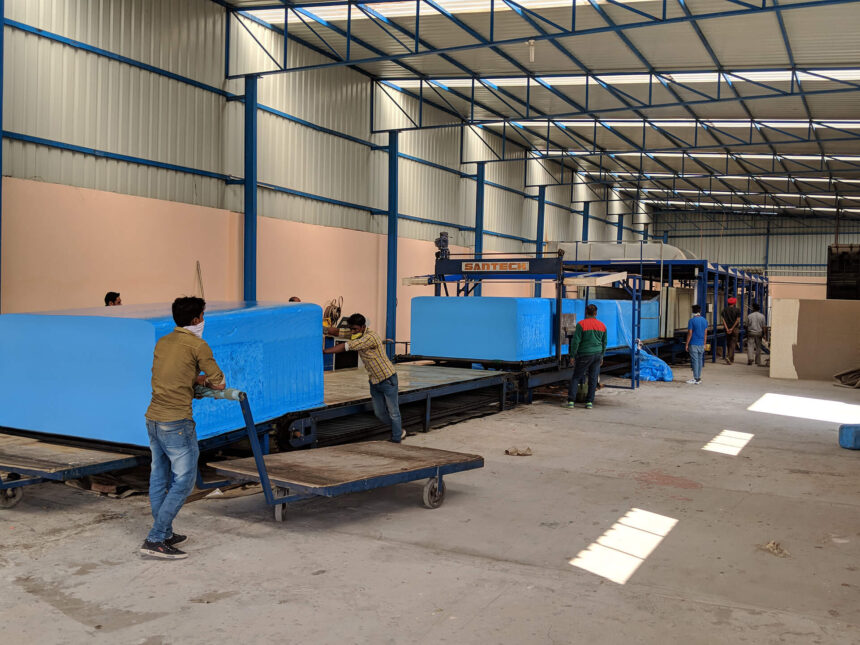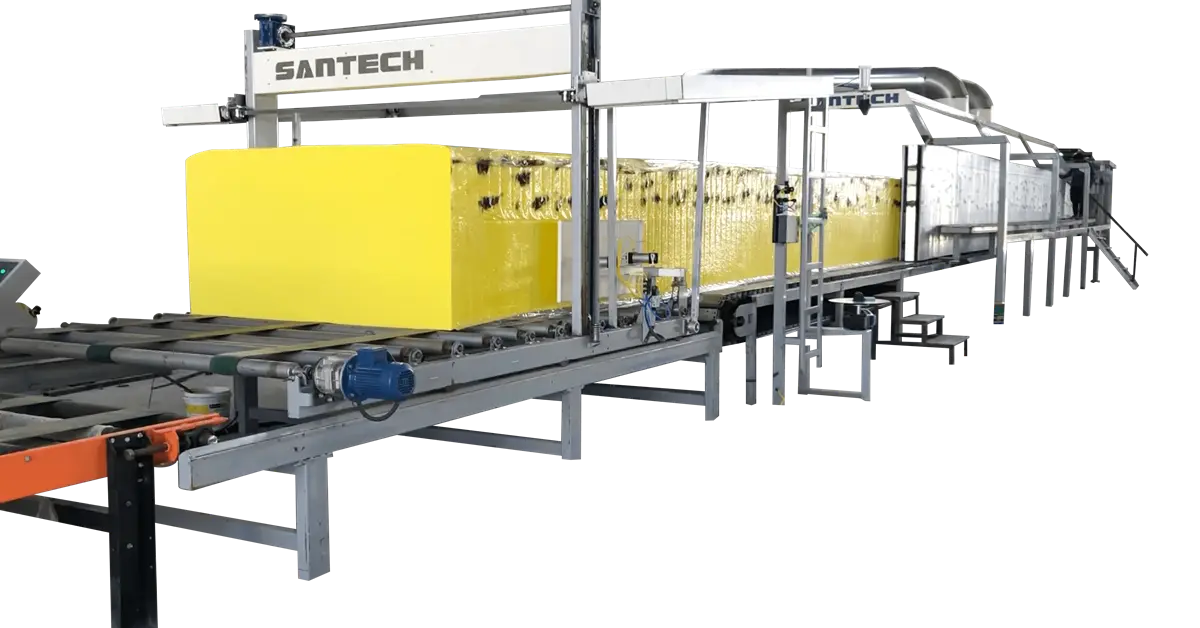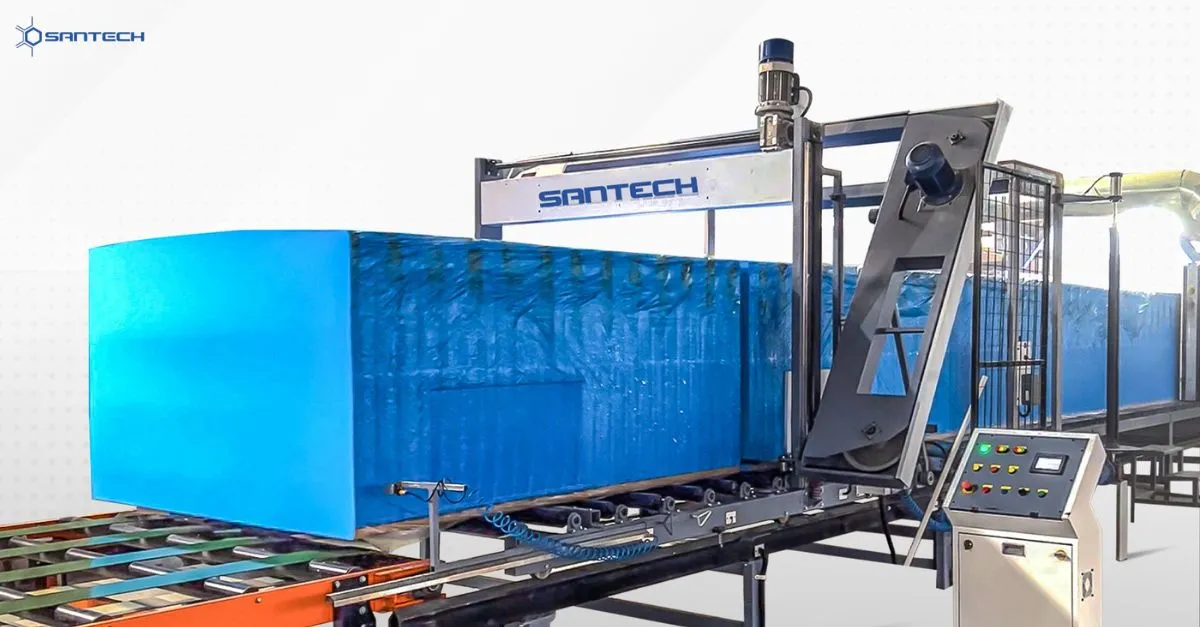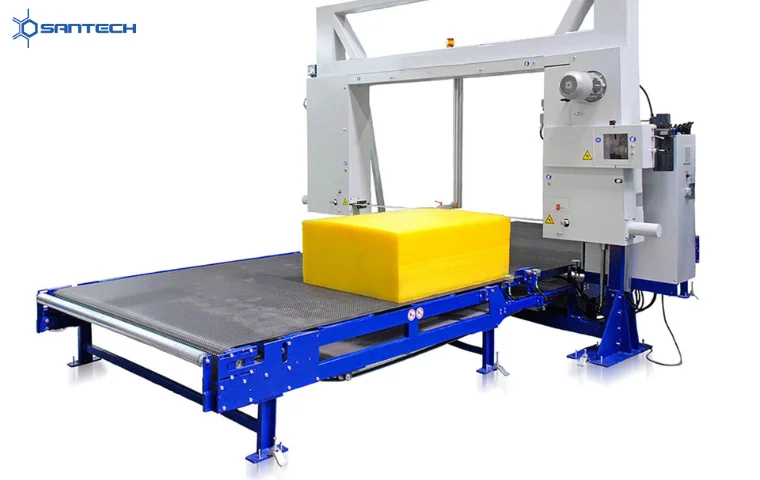Foam plants manufacture Polyurethane foam, which is widely used in multiple sectors. For example, the elastic nature of PU foam is now used in bedding, furniture, and packaging. One of the main reasons behind this foam usage boost is foam plants with proper equipment.
In a foam plant, foam cutting machines cut big PU foam blocks into desirable shapes and sizes for commercial uses. Foam cutting machines are made from varied materials; while some have cutters or blades, the most commonly used is a hot wire. A foam plant also features several foaming machines in different shapes and sizes meant for their multiple uses in diverse industries.
PU foam has become notoriously famous recently, primarily because of the booming mattress industry. We’ll look at more details about the workings of a Foam Plant, the manufacture of PU foam, and the chemicals involved in the process below.
How Is Foam Manufactured In Foam Plants?
Here’s a simple and short explanation explaining the creation of foam products. Please note that we can’t give shape to the foam slabs with a foaming machine, but we can use different foam cutting machines to provide a form to the foam.
⦾ Polyurethane foam requires several raw materials like polyol, blowing agent (water), isocyanate, and catalysts. All these chemicals are then poured into a mixer container in exact amounts.
⦾ All the chemicals are mixed and placed on a moving surface, like a conveyor. With time the heat is released, and the polyurethane starts foaming as it travels through the conveyor.
⦾ Excessive heat can be released using isocyanate and water and complex Ventilation systems.
⦾ After the foam gets dried, the bubbles from the foam start to enlarge and turn into soft porous material after a point in time.
Continuous foam machines are more profitable than batch foam machines. This is because you can produce larger quantities and better-quality foam products, increasing profits rapidly.
Foam Making In Foam Plant
Foam Making In Foam Plant
What Chemicals Make-up Foam?
Many chemicals are used in a foam plant during the manufacture of foam in large quantities. Generally, 40% isocyanate, 10% blowing agents like water, 50% polyols, and a small number of catalysts. Isocyanates and polyol are mixed under observation, and the mixtures start exothermic reactions.
Foam plants use different types of isocyanates to produce various qualities of foam. For example, MDI produces hard foam slabs while TDI makes softer foam slabs. In addition, catalysts like Tin octet and tertiary amines are often used in a Foam plant to speed up the foam production process, allowing large-scale production.
How Is Rebonded Foam Made?
Rebonded foam, more commonly known as recon foam, got its name from the process of its manufacture from reclaimed foam pieces. It is an open cell PU, famous for its endurance and long lifetime. In a foam plant, polyurethane is mixed with residue foam slabs in a liquid state to create rebonded foam. You can also cut in your desired shape to make the best out of this type of foam the best.
Rebonded foam is only very flexible and one of the most versatile foam types mainly because of the various density of foam materials used during its production. It is considered one of the best for modern commercial and industries. Rebonded foam is used in bars, gyms, and public vehicles.
Batch And Continuous Foam Machines
Foaming machines generally come in two types: batch foam machines and continuous foam machines. You can choose from either of two devices, depending on the scale of your average production.
Batch Foam Machines
Batch foaming machines make PU foam slabs on small scales, creating vast quantities of foam in a single round. A batch foaming machine is mighty and effective in manufacturing PU foam quality blocks, making vast amounts of foam in a single round. This foaming machine is available for low prices because of its low quantity production rate.
Batch Foaming machine
Batch Foaming machine
Pros Of Using Batch Foam Machine:
You can get particular advantages if you buy batch foaming machines. You can also choose from manual and automatic batch foam machines.
Although, most batch foam machines can only manufacture foam sheets/ blocks in low quantities. However, batch foam machines can manufacture dense foam blocks ranging up to 50kg/m3.
Batch foam machines also feature a motor to help you control the mixing process. This also makes sure that the product has a balanced composition in the end.
The TD is a feeding system, and the polyol aids the batch foam machines in producing a better and more efficient quality of foam blocks.
Continuous Foaming Machines In Foam Plants
Continuous foaming machines are designed to maximize the industrial production of foam sheets or slabs. The main objective is to make large-scale quality foam products. Foam plants and futuristic industries use continuous foaming machines. One difference between this foaming machine and batch type is that the entire process happens at one location. Continuous foam machines got their name from making foam products on a machine for long periods.
Continuous Foaming Machine
Continuous Foaming Machine
Advantages Of Continuous Foaming Machines
Continuous foaming machines are generally costly and also require numerous other materials for the production of foam to start. Continuous foaming machines might seem like a challenging investment, but the rewards you can outweigh these minor reasons. Some of them are –
⦾ Setting Up Presence In The Market:
A Continuous foaming machine can help you gain popularity and influence in a consumer market by producing quality foam products consistently on a large scale. You can easily penetrate if you have a stable supply chain and companies that deal with foam products. The expense might be considerable, but the profits will be simply significant.
⦾ Significantly Less Competition In The Markets
Many people in business back off from getting into the foam manufacturing business as the business cost of continuous foaming machines and producing these products are pretty high. Also, once you’ve taken a particular hold over the market, it becomes increasingly difficult for your competitors to catch up to you.
⦾ Less Cost Of Materials
As continuous foam machines only support big-scale foam production, it can save you while buying raw materials for the process. Generally, raw materials are needed in huge quantities, saving you money. This process, in turn, also allows you to expand your market reach.
Foam Cutting Machines
Several other types of machinery are needed during foam production in a plant. Each foam slab is cut by using various cutting machines. Vertical cutting machines and Circular cutting machines are one of the most popular foam cutting machines used by maximum foam plants.
⦾ Vertical Foam Cutting Machines
Vertical cutting machines specialize in cutting down big slabs of foam into smaller pieces according to market demand. They’re also great at shaping the edges of foam blocks. As a result, vertical foam cutting machines are one of the best equipment for cutting foam slabs in a foam plant.
⦾ Vertical Foam Cutting Machines
Vertical Foam Cutting Machines
⦾ Horizontal Foam Cutting Machines
Horizontal foam cutting machines are great at decreasing the thickness of the foam blocks very efficiently while maintaining top-notch quality. Therefore, a horizontal foam cutting machine is considered ideal for most mattresses.
⦾ Circular Foam Cutting Machines
Circular cutting machines are used for cutting thick foam slabs into circular shapes with high accuracy and extreme thoroughness. The foam slabs are placed on a circular table and experience rotary movement powered by an AC motor. Circular cutting machines can cut down foam slabs from 200 mm to as low as 3 mm.
What Are The Different Kinds Of Foam?
⦾ Polyurethane Foam:
Polyurethane Foam is also called poly-form and is well known for its budget-friendly nature. It is one of the most commonly used forms of foam. The chemistry behind the production of polyurethane foam is unique. Its molecular structure is relatively rigid and flexible, with a life span of 3 years. It is considered an excellent insulator of electricity. And the substantial bonding property makes it resistant to oil, water, and grease.
⦾ Memory foam:
Memory foams are always in high demand in the market. The name is quite suggestive of its experience, as the foam will deflate as soon as you apply pressure to it. In addition, it’s softer than Gel foam and polyurethane foam. People also favor memory foam over Rebonded foam because of its 10-year life span. However, memory foam is denser than other types of foam, and it goes back to its original state once you get up.
⦾ Rebonded foam:
Rebonded foam, more commonly known as recon foam, got its name from the process of its manufacture from reclaimed foam pieces. It is an open cell PU, famous for its endurance and long lifetime. In a foam plant, polyurethane is mixed with residue foam slabs in a liquid state to create rebonded foam. Rebonded foam is only very flexible and one of the most versatile foam types mainly because of the various density of foam materials used during its production. Therefore, it is considered one of the best for modern commercial and industries.
PU Foam Plants
Foam plants manufacture Polyurethane foam using batch and continuous machines, widely used in multiple sectors. The elastic nature of the PU foam is now used in bedding, furniture, and packaging. One of the main reasons behind this foam usage boost is foam plants with proper equipment and planning of the foam plant. Foam machines typically cost from 5 lakhs to 25 lakhs.
In a foam plant, foam cutting machines cut big PU foam blocks into desirable shapes and sizes for commercial uses. Foam cutting machines are made from varied materials; while some have cutters or blades, the most commonly used is a hot wire.
Conclusion
The demand for foams has increased with the evolution of various hybrid foams like soy-based high resiliency foam or memory foam. Therefore, a foam plant needs to have highly efficient machinery in the residential or commercial sector to keep up with mass demand.
Choose the best foam-making and cutting machines for your foam plant from the best foam machine manufacturers like Santech Industries at the best prices. They offer a blend of advanced technology with affordability without compromising quality. Visit their website to find the machine that resonates with you and enjoy the outstanding performance of a power-driven brand, Santech.




